
Hydrographic survey is the science of measurement and description of features which affect maritime navigation, marine construction, dredging, offshore wind farms, offshore oil exploration and drilling and related activities. Surveys may also be conducted to determine the route of subsea cables such as telecommunications cables, cables associated with wind farms, and HVDC power cables. Strong emphasis is placed on soundings, shorelines, tides, currents, seabed and submerged obstructions that relate to the previously mentioned activities. The term hydrography is used synonymously to describe maritime cartography, which in the final stages of the hydrographic process uses the raw data collected through hydrographic survey into information usable by the end user.

The Office of Marine and Aviation Operations (OMAO) is a division of the National Oceanic and Atmospheric Administration (NOAA) which operates a wide variety of specialized ships and aircraft to carry out the environmental and scientific missions of NOAA.

NOAAS Rude was an American Rude-class hydrographic survey ship that was in commission in the National Oceanic and Atmospheric Administration (NOAA) from 1970 to 2008. Prior to its NOAA career, it was in commission in the United States Coast and Geodetic Survey from 1967 to 1970 as USC&GS Rude. It was named for Gilbert T. Rude, former Chief of the Division of Coastal Surveys of the Coast and Geodetic Survey.

NOAA Ship Fairweather, originally operated by the United States Coast and Geodetic Survey as USC&GS Fairweather, is an oceanographic research ship operated by the National Oceanic and Atmospheric Administration (NOAA). Fairweather primarily conducts hydrographic surveys in Alaskan waters, but is considered a multi-mission-capable vessel and has conducted fisheries research cruises. She is the sister ship of the NOAAS Rainier and of the retired NOAAS Mount Mitchell.
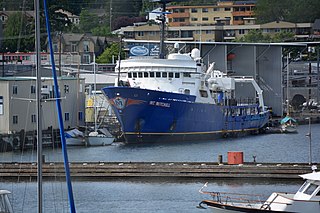
NOAAS Mount Mitchell was an American survey vessel in commission in the National Oceanic and Atmospheric Administration from 1970 to 1995. Prior to her NOAA career, she was in commission in the United States Coast and Geodetic Survey as USC&GS Mount Mitchell from 1968 to 1970. In 2003, she returned to service as the private research ship R/V Mt. Mitchell.
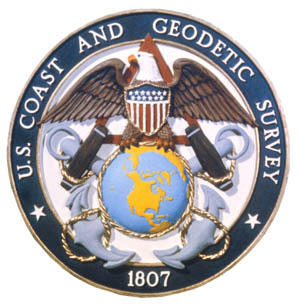
The United States Coast and Geodetic Survey, known from 1807 to 1836 as the Survey of the Coast and from 1836 until 1878 as the United States Coast Survey, was the first scientific agency of the United States Government. It existed from 1807 to 1970, and throughout its history was responsible for mapping and charting the coast of the United States, and later the coasts of U.S. territories. In 1871, it gained the additional responsibility of surveying the interior of the United States and geodesy became a more important part of its work, leading to it being renamed the U.S. Coast and Geodetic Survey in 1878.
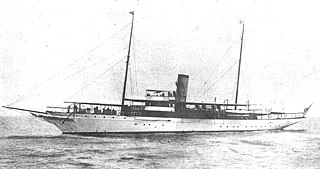
USS Lydonia (SP-700) was United States Navy patrol vessel in commission from 1917 to 1919 that saw service during World War I. Prior to her U.S. Navy service, she had been William A. Lydon's private yacht, Lydonia II, from 1912 to 1917. She spent most of the war based at Gibraltar, escorting and protecting Allied ships in the Mediterranean and along the Atlantic Ocean coast of Europe. After her U.S. Navy service ended, she served from 1919 to 1947 in the United States Coast and Geodetic Survey as the coastal survey ship USCGS Lydonia (CS-302).

USS Mobjack (AVP-27/AGP-7) was a motor torpedo boat tender in commission in the United States Navy from 1943 to 1946. She saw service in the Pacific theater during the latter portion of World War II.

NOAA Ship Surveyor was an oceanographic survey ship in commission in the National Oceanic and Atmospheric Administration (NOAA) from 1970 until 1995. Prior to her NOAA career, she was in commission in the United States Coast and Geodetic Survey from 1960 to 1970 as USC&GS Surveyor. She was the second and last Coast and Geodetic Survey ship named Surveyor and has been the only NOAA ship thus far to bear the name.
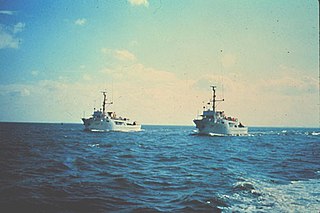
NOAAS Heck was a Rude-class hydrographic survey ship in the National Oceanic and Atmospheric Administration (NOAA) from 1970 to 1995. Prior to her NOAA service, she was in commission from 1967 to 1970 in the United States Coast and Geodetic Survey as USC&GS Heck.

NOAAS Davidson was a survey ship in commission in the National Oceanic and Atmospheric Administration (NOAA) from 1970 to 1989. Prior to her NOAA service, she was in commission in the United States Coast and Geodetic Survey from 1967 to 1970 as USC&GS Davidson, the second Coast and Geodetic Survey ship of the name. She was the only sister ship of NOAAS McArthur (S 330).
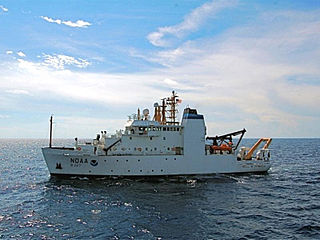
NOAAS Bell M. Shimada is an American fisheries research ship in commission with the National Oceanic and Atmospheric Administration (NOAA) since 2010. She operates along the United States West Coast.

NOAAS Reuben Lasker is a National Oceanic and Atmospheric Administration (NOAA) fishery research vessel. The ship's namesake, Reuben Lasker, was a fisheries biologist who served with the Southwest Fisheries Center, National Marine Fisheries Service, and taught at the Scripps Institution of Oceanography.
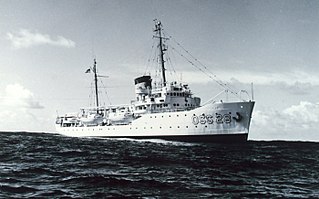
The second USC&GS Explorer was a survey ship that served in the United States Coast and Geodetic Survey from 1940 to 1968. She operated in the Pacific Ocean from 1940 to 1960, seeing service there during World War II, and in the Atlantic Ocean from 1960 to 1968.

NOAAS Whiting, was an American survey ship that was in commission in the National Oceanic and Atmospheric Administration (NOAA) from 1970 to 2003. Previously, she had been in commission in the United States Coast and Geodetic Survey from 1963 to 1970 as USC&GS Whiting.

NOAAS Oregon II is an American fisheries research vessel in commission in the National Oceanic and Atmospheric Administration (NOAA) fleet since 1977. Prior to her NOAA career, she was delivered to the United States Fish and Wildlife Service's Bureau of Commercial Fisheries in 1967 as US FWS Oregon II, but not commissioned. She was transferred to NOAA in 1970, but was not placed in commission until 1977.

NOAAS Townsend Cromwell was an American fisheries research vessel that was in commission in the National Oceanic and Atmospheric Administration (NOAA) fleet from 1975 to 2002. Prior to her NOAA career, she was in the United States Fish and Wildlife Service's Bureau of Commercial Fisheries fleet from 1963 to 1975 as US FWS Townsend Cromwell.

NOAAS David Starr Jordan (R444)) was an American fisheries research vessel in commission in the National Oceanic and Atmospheric Administration (NOAA) from 1970 to 2010. She previously was in the United States Fish and Wildlife Service's Bureau of Commercial Fisheries fleet from 1966 to 1970 as US FWS David Starr Jordan.
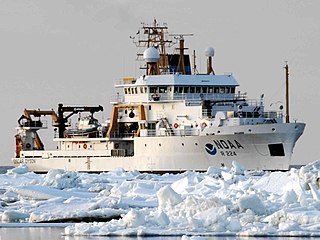
NOAAS Oscar Dyson is an American fisheries and oceanographic research vessel in commission in the National Oceanic and Atmospheric Administration (NOAA) fleet since 2005.

USS PCS-1405 was a United States Navy minesweeper in commission from 1944 to 1946. She saw service in the latter stages of World War II.





















